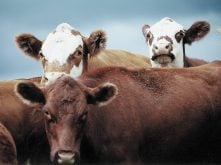Fed prices rise
Weighted average steer prices rose $1.75 to $148 per hundredweight in light to moderate trade, and heifers were steady at $145.
U.S. buyers did not actively bid.
Calf numbers increased.
The cash-to-futures basis narrowed $1 to -$11.79.
The basis is expected to strengthen sharply, closer to the five-year average of -$4.45.
The weekly sales volume rose 44 percent to 12,153 head, which was three percent smaller than the same week last year.
Weekly western Canadian fed slaughter to April 26 rose 23 percent to 36,735 head. Slaughter is up seven percent this year.
Read Also

Prairies have variable soil moisture conditions
The dry weather in the west was welcome for preserving grain quality and advancing harvest, but it has resulted in very dry soil moisture conditions.
Weekly exports were down 25 percent at 9,236 head to April 19, which was a holiday-shortened week.
Packers have maintained cut-out values to improve margins, but retailers are struggling to increase beef prices.
North American market ready supply should increase, but the number of cattle that traded on the cash market should remain limited.
Increased supply could weaken live cattle prices, but an improved basis should remove some of the sting.
Cows post records
Cows were $2-$4 higher with D1, D2 ranging $100-$114 to average $107 and D3s ranging $90-$105 to average $96.33.
Rail grade cows were $200-$205.
Western Canadian cow slaughter totalled 4,861 head, which was the fourth week in a row that the total was below last year.
Butcher bulls averaged $112.36.
Canadian bull exports to the United States are up 19 percent this year over last year, while western Canadian bull slaughter is up nine percent.
Strong prices for butcher bulls have encouraged producers to upgrade to new genetics. Also, the cold winter caused reproductive issues.
Feeder market strong
Prices for 550-650 pound steer have soared by one-third since the start of the year.
North American competition for bunk replacements and grass cattle remains strong, but feedlot margins are squeezed at these prices.
Producers who fatten cattle on grass have bought record high priced cattle and will need historically high feeder prices to see a profit.
Increased financial risk brings with it a need to protect margins.
Forward delivery contracts for yearlings over the past couple of weeks have risen $3-$5.
More specifically, 1,000 lb. steers for August-September delivery are now in the low $170s, up from the upper $160s.
Some calves have been offered for late fall delivery, but from a buyer’s standpoint there is added market risk. Feedlots are unable to contract calves to the packers because no fed contracts are currently being offered out past May.
Chicago feeder futures are volatile, but prices last week suggested that prices for 750-775 lb. steers could be a record $1.92 per lb. this fall in the U.S.
Converted to Canadian dollars, this equates to $2.11 per lb., less a basis. The basis has been volatile, but a seasonal basis of -$5 per cwt. would equate to 750 lb. steer prices in Alberta at $2.06 per lb. this fall.
U.S. beef prices fall
The U.S. Choice cutout was $230.34 US per cwt., down $3.46, and Select was $220.98, down $1.09.
Prices rose early in the week but fell sharply May 1 with light to moderate demand and moderate to heavy offerings.
Reduced retail feature activity, coupled with larger U.S. slaughter, may keep buyers on the sidelines waiting for new discounts. U.S. slaughter was up 3.9 percent to 608,000 head.
Weekly Canadian cutout values to April 26 were not available.
The cold storage report released this week shows that frozen and chilled beef inventories April 1 were down 13 percent, or 3,540 tonnes from a year ago. This is expected to provide support to beef prices.
Montreal wholesale prices for this week were anticipated to be steady at $262-$264 Cdn per cwt.
This cattle market information is selected from the weekly report from Canfax, a division of the Canadian Cattlemen’s Association. More market information, analysis and statistics are available by becoming a Canfax subscriber by calling 403-275-5110 or at www.canfax.ca.














